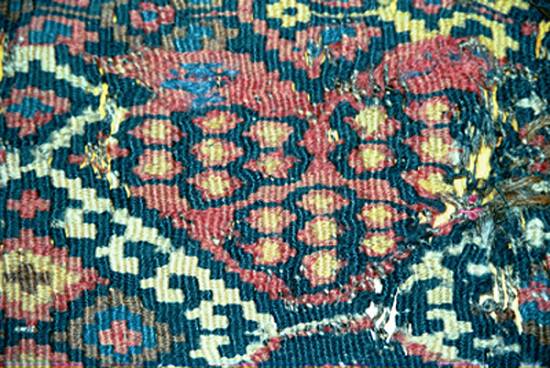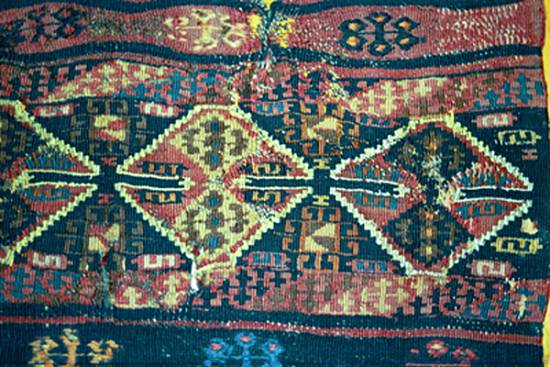Posted by Matthew J. Miller on 12-13-2004 12:44 PM:
anatolian cuval face



greetings everyone,
i'm
new here, and not a whiz with the computer so please forgive me if these images
turn out to be difficult to view. thanks Filiberto, for doctoring the images as
well as putting up with the ten minutes of downloading.
this is
(presumably) an old anatolian slit-woven cuval face that i find very pleasing
and lovely, even in its state of great decrepitude. the weaving was crisply and
presicely executed and the colors are luminous and rich; i especially like the
overdyed indigo and the yellows. it measures 160cm x 170 cm, and i suppose that
it was considerably longer before being cut.
i'm not sure about all of
the materials; the warps appear to be z-spun wool and goat hair while the wefts
are mostly wool with some metal-wrapped (metal remaining only between the nodes)
cotton threads used to outline some of the diamond shaped motifs as well as on
the end borders. i suspect also that there is also some natural brown wool
present in the weaving.
as to where it is from, my instincts such as
they are, steer me toward the malatya-sivas region of anatolia, but really i
have no idea. there are fifteen motifs that are visible on the two large bands
on either side of the large central band: squares with alternating kocboynuzu
and elibelinde, as i have heard this described. what interests me is that in the
center of the square, it has been divided in half, and each resulting rectangle
has been diagonally halved; four triangles in the center of each is the result,
and this i have not come across before. as to its age, it has been suggested to
me by several reputable and or knowledgeable people that its "quite old". i find
it perplexing to date cuvals, and i have never seen a published example that
closely resembles this one.
any ideas or comments would be greatly
appreciated.
thanks for reading,
matthew
__________________
panton
metron anthropos
Posted by Patrick Weiler on 12-13-2004 08:40 PM:
Which end is up?
Matthew,
Your piece looks like Malatya, but could also be
Yahyali.
Which end is up?
It couldn't have been woven any earlier than
1967, due to the design in the middle panel (bottom photo shows it best) which
was obviously woven by a Hippie on acid, circa mid 1960's. 
You mention squares in two of
the panels, but they look more like diamonds.
If it was longer, do you
think that it would have been just the (usually) striped, plain-woven back that
is missing?
Is there any closure system remaining?
I think it is quite
a lovely piece, full of movement and color.
Patrick Weiler
Posted by Matthew J. Miller on 12-13-2004 09:35 PM:
greetings patrick,
the yellow does (in person) have that yahyali
quality to it as do the staggered motifs in the center of photo 3.
which
end is up? i didn't bother to rotate the pictures in photoshop which might have
made things easier.... in the first and third photos, the warps are horizontal
and the middle photo shows the piece with warps vertical.
what a relief!
i was really hoping that it was not woven later than my birth year of 1970; at
least its older than i am.
what i was attempting to point out is best
seen in photo 2: not the three diamonds, which the weaver obivously saw while on
the acid trip, but the motifs in the negative space in between them. i have seen
these referred to signifying oguz clan affiliation, but i haven't a clue really.
four of these are well in view in photo 2, but the one on the lower left of the
middle diamond has been obliterated and crocheted shut with very thick and
coarse yarn, maybe goat or horse hair. the description in my previous post still
applies, and i hope this helps you find it; if not, i will send another bad
image of a close-up. i should add that this general motif is very familiar to
me, as it resides happily on a few of my east anatolian kilims, but not with the
'four triangles' twist. none of my 15 or so kilim books provide a direct analog,
either.
i presume that it was longer because in photo 1, the end on the
left is very different than the one on the right, and the blue band seems a
strange way to end things. that's just my guess, though. no, there are no
remnants of a closure system, no straps to indicate what it really was or is.
in the first photo, on the first blue band from the left are brocaded
motifs that i usually associate with eastern anatolian cuvals, but that's about
it in terms of why i have been calling it a cuval.
a friend of mine
suggested that it could be a fragment of a larger two-piece kilim because as
seen at the bottom of the center band of photo one, the motifs stop at the half
way point. i'm glad you like this ____, i sure do too.
thanks for
reading,
matthew
__________________
panton
metron anthropos
Posted by Patrick Weiler on 12-14-2004 01:31 AM:
Memlings
Matthew,
When you point out the motifs described as "oguz clan
affiliation",
I believe you mean the devices known as Memling Guls. There is
one in each corner of the Khamseh bag shown in a different thread on this
salon:

I do not
readily recall any Memling Guls with your particular central design. It is a
very dynamic version, with a swirling, kinetic feel.
You have 15 kilim
books? I did not know that there were that many!
Kilim, The Complete Guide,
shows a couple of flatweaves from the Central Asian Kazakh region with the
Memling Gul, but they are not slit-weave construction. It is probably not as
common in slit-weave tapestry designs due to the long, straight sections which
would tend to weaken the structure. Slit-weave designs favor diagonal
motifs.
I was kidding about the mid-60's age. It is more likely mid 90's.
1890's.
Patrick Weiler
Posted by Matthew J. Miller on 12-14-2004 02:10 AM:
hi patrick,
i have never heard of this partcular kilim motif referred to as a memling
gul, although i am familiar with memling guls and do see the similarities. the
small motifs i am referring to are not found in the central panel, but on the
two panels on either side.
plates 71 and 72, both long malatya region
kilims in _flatweaves of turkey_ by arend bandsma and robin brandt, display
analogous motifs to my piece, while plate 74 and 76 display what i have always
considered to be memling guls. see also marlamallett: memling gul for
what i consider to be a classic flatwoven memling.
books? i collect books
as well, and i suppose that some to which i referred are kilims and pile both,
but i'm fairly sure that i have that many kilim books, not all of which were
published in english. some, like _persian kilims_ by alastair hull are not
anatolian, per se, but flatweave oriented nonetheless. if you're interested i
can compile a list.
my tounge was fairly well in cheek when i said that i
was relieved that it is older than i am. the acid trip inspired design reference
tipped me off :-)
what makes you think late 19th. c.?
thanks for
reading,
matthew]
__________________
panton
metron anthropos
Posted by Matthew J. Miller on 12-18-2004 11:55 AM:
a few more images
below are a few more images that are hopefully of a higher resolution.
best,
matthew



__________________
panton
metron anthropos
Posted by Patrick Weiler on 12-19-2004 03:59 PM:
Eyeball?
Matthew,
The close up shots are great. I am not familiar with the
design motif in your first photo. Either it is a clump of grapes, or a close up
of the eyeball of a housefly.
Have you found any other weavings with this
peculiar design?
And the "S" motifs inside rectangles with a tip at each end
are unusual, too. The Khamseh bag I showed above has "S" motifs, but they are
not inside a box. They are free floating. The Malatya kilim I showed earlier in
the salon has "S" motifs also, free floating. I will try to round up some
pictures.
Patrick Weiler
Posted by Matthew J. Miller on 12-20-2004 12:49 PM:
eyeballs
hi patrick,
glad you like the close-ups. one of my malatya kilims, a
smaller piece with three large kocboynuzu motifs occupying the field contains
many 'eyeball' motifs at the ends of the ram horns as well as in much of the
negative space. i have heard this referred to as a flower or as a pommegranate;
fly eyes are fine with me, however. i have also seen it on quite a few east
anatolian pieces; a variant of it on some reyhanli sandikli kilims comes also to
mind. in the third photo of the second group that i posted shows a better view
of the 'memling' motif in question in the above posts. more visible are the four
triangles in their centers which i was trying to point out previously. this
motif (with a different design at its center) also occurrs on the malatya kilim
just described, although with much less frequency.
__________________
panton
metron anthropos
Posted by Patrick Weiler on 12-21-2004 12:31 AM:
Memling square
Matthew,
Here is a photo of a Fachralo Kazak.

You can see that there is a
motif in each corner of the green field that is quite similar to the motif in
the center of your Memling guls. In this case, there are twice the number of
triangles as in your weaving, but the swirling, dynamic design is the
same.
This rug only lacks the Memling hooked outline to each motif.
And
notice the Christmas red-and-green colors!
Patrick Weiler
Posted by Matthew J. Miller on 12-24-2004 12:52 PM:
lovely rug, particulary the reindeer. could it be the case that this has been
misakenly identified as a prayer rug, when in fact it could be a pictoral
representation of santa claus's home at the north pole, guarded by the reindeer,
rather than a 'mihrab'? might this be the more likely story?
cheers,
matthew
__________________
panton
metron anthropos








